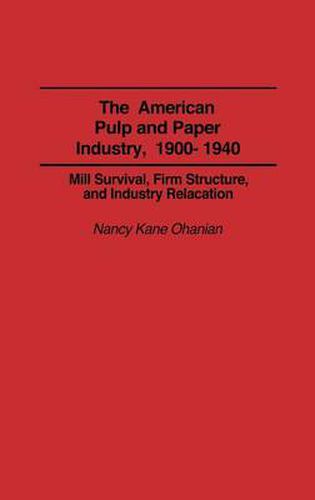Readings Newsletter
Become a Readings Member to make your shopping experience even easier.
Sign in or sign up for free!
You’re not far away from qualifying for FREE standard shipping within Australia
You’ve qualified for FREE standard shipping within Australia
The cart is loading…






This book examines the U.S. pulp and paper industry between 1900 and 1940, the period when pulp and paper production relocated from the North to the South and the West. This relocation was one of the most influential shifts in industrial production in the 20th century, ranking second in extent of out-migration only to the exit of the cotton textile industry in roughly the same period. This study focuses on the reason for the shift, with an emphasis on the interrelationships among firm location, industrial structure, vertical integration, and firm survival and growth.
The work opens with an introductory summary of the economic background of the industry during the period and, then, provides a more detailed description of economic trends in pulp and paper production from 1900 to 1940. Chapter 3 analyzes the relocation of pulp and paper production to the South and the Pacific Coast. Chapter 4 discusses the structure of the industry in light of modern industrial organization theory. The vertical integration of pulp and paper production is covered in chapters 5 and 6, and chapter 7 analyzes mill survival and growth. The final chapter reviews the study’s major findings. The book will be of interest to economic historians, industrial economists, and students of economic geography, development economics, and regional economics.
$9.00 standard shipping within Australia
FREE standard shipping within Australia for orders over $100.00
Express & International shipping calculated at checkout
Stock availability can be subject to change without notice. We recommend calling the shop or contacting our online team to check availability of low stock items. Please see our Shopping Online page for more details.
This book examines the U.S. pulp and paper industry between 1900 and 1940, the period when pulp and paper production relocated from the North to the South and the West. This relocation was one of the most influential shifts in industrial production in the 20th century, ranking second in extent of out-migration only to the exit of the cotton textile industry in roughly the same period. This study focuses on the reason for the shift, with an emphasis on the interrelationships among firm location, industrial structure, vertical integration, and firm survival and growth.
The work opens with an introductory summary of the economic background of the industry during the period and, then, provides a more detailed description of economic trends in pulp and paper production from 1900 to 1940. Chapter 3 analyzes the relocation of pulp and paper production to the South and the Pacific Coast. Chapter 4 discusses the structure of the industry in light of modern industrial organization theory. The vertical integration of pulp and paper production is covered in chapters 5 and 6, and chapter 7 analyzes mill survival and growth. The final chapter reviews the study’s major findings. The book will be of interest to economic historians, industrial economists, and students of economic geography, development economics, and regional economics.